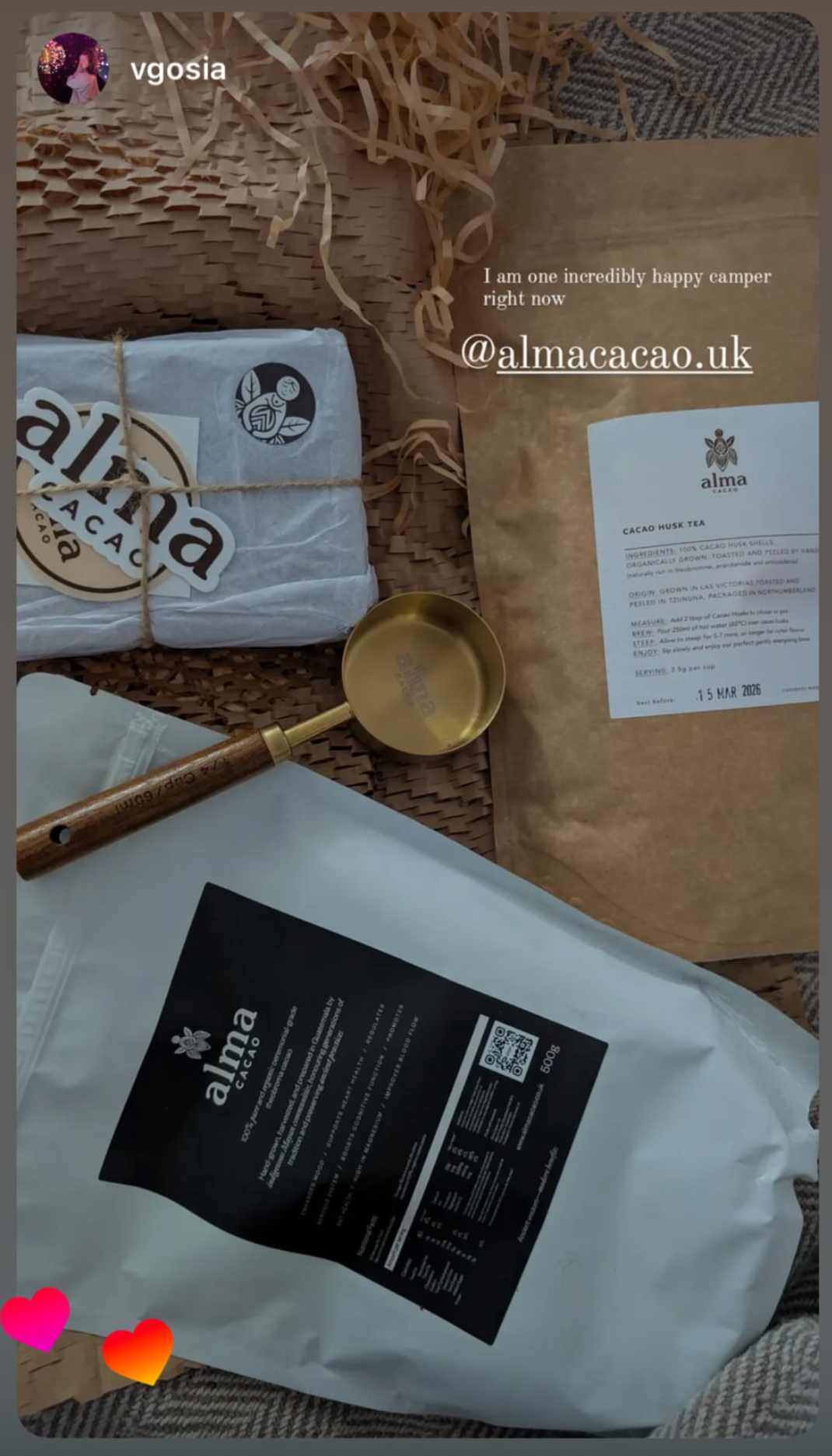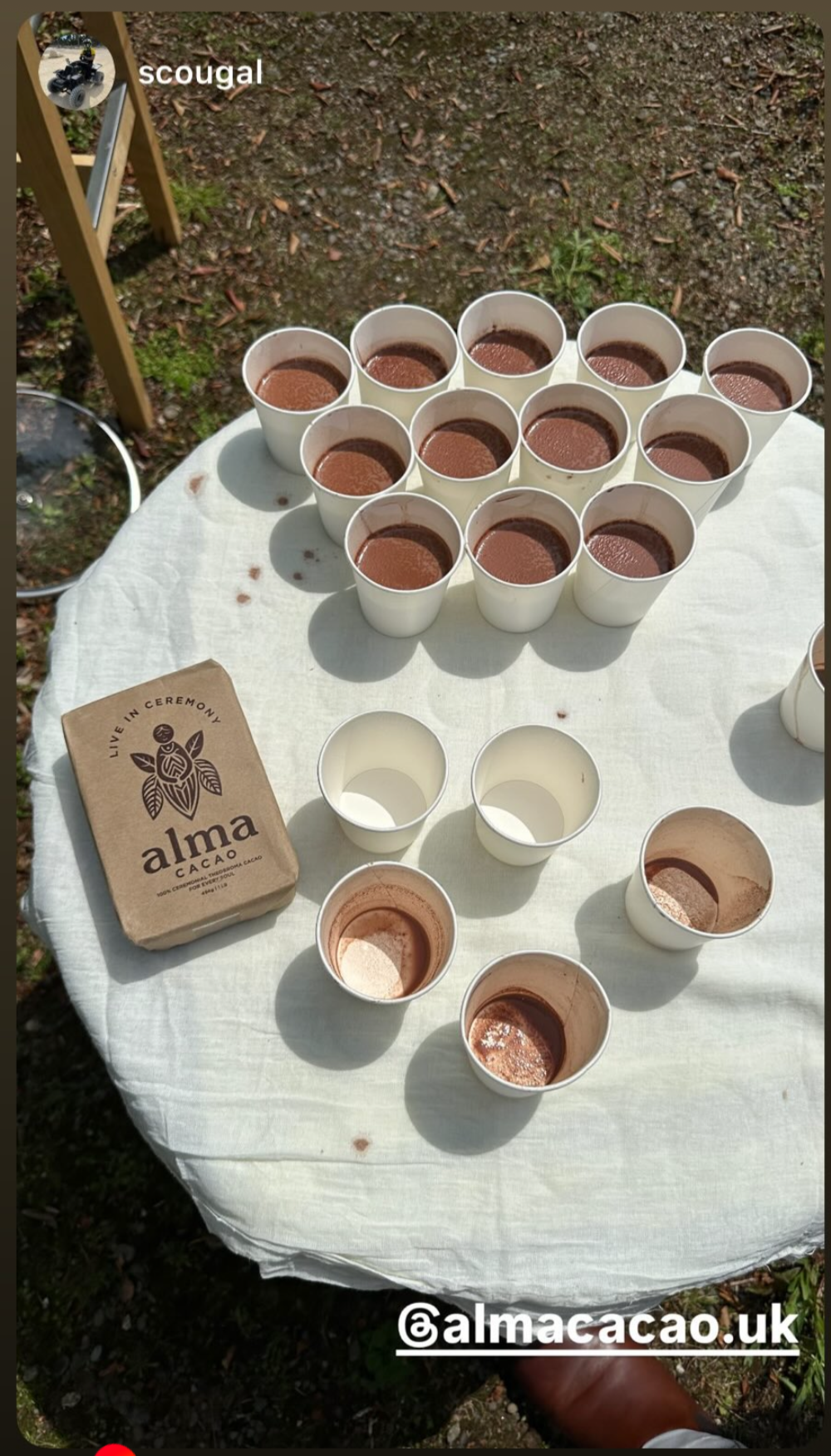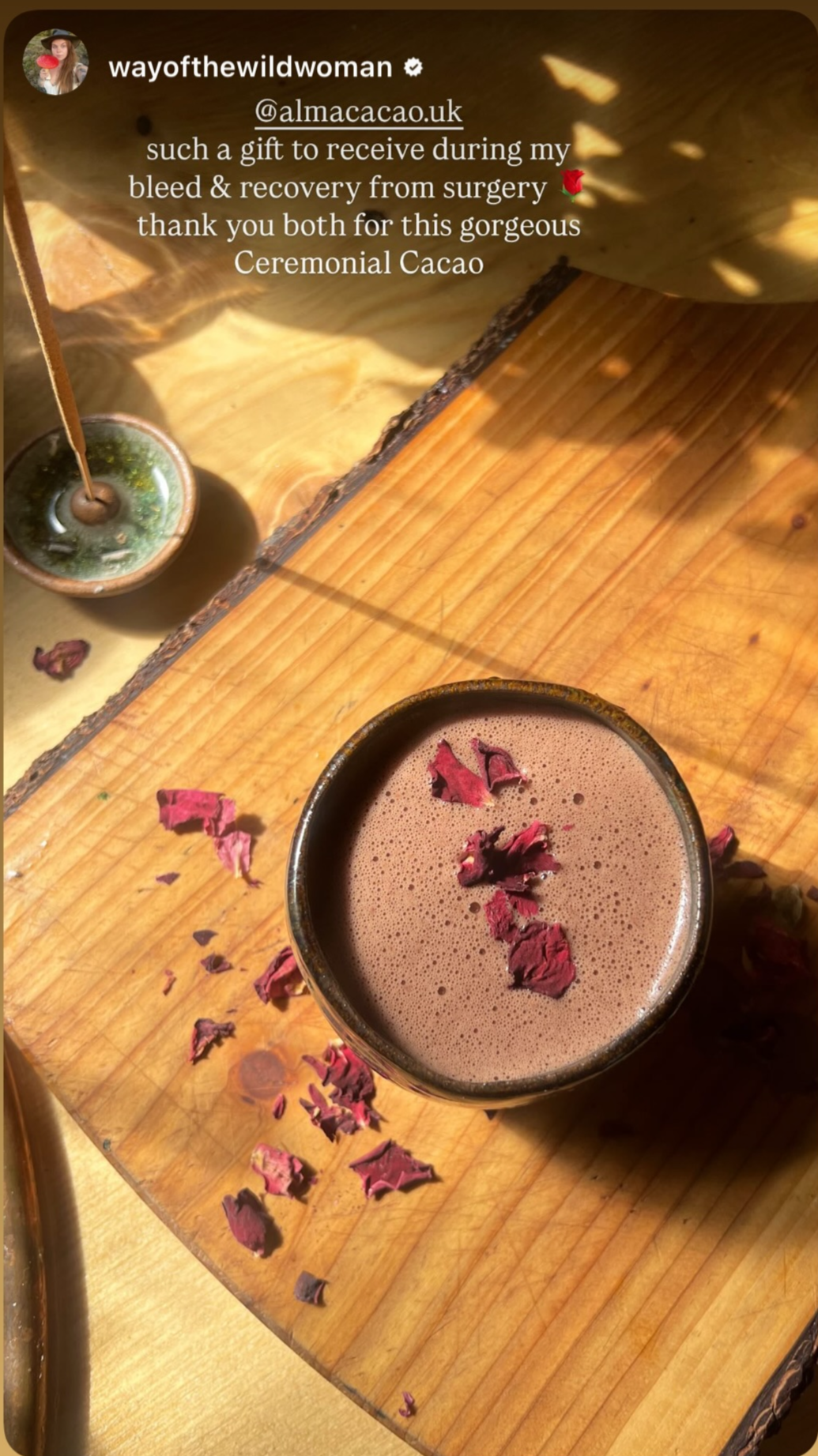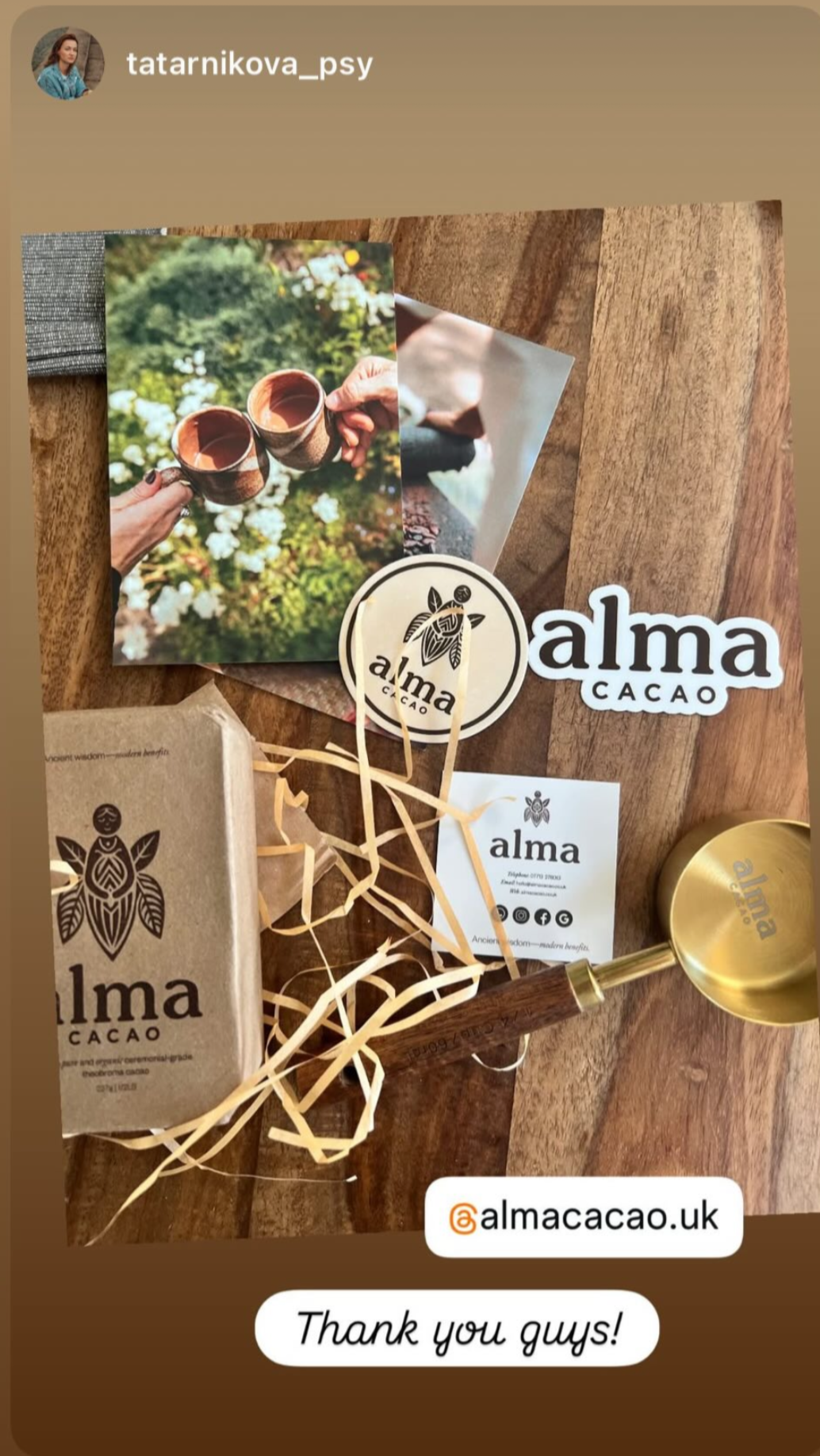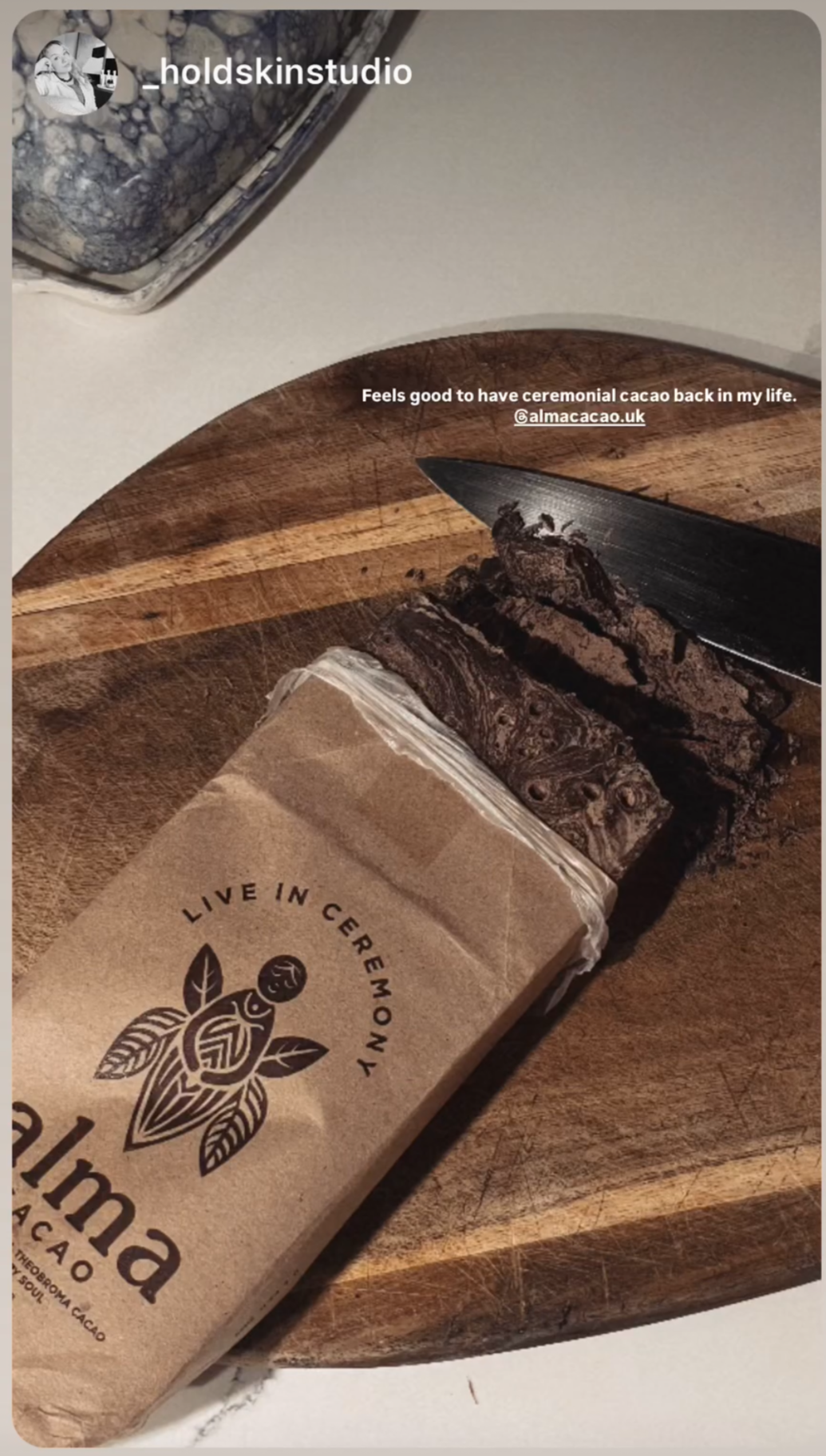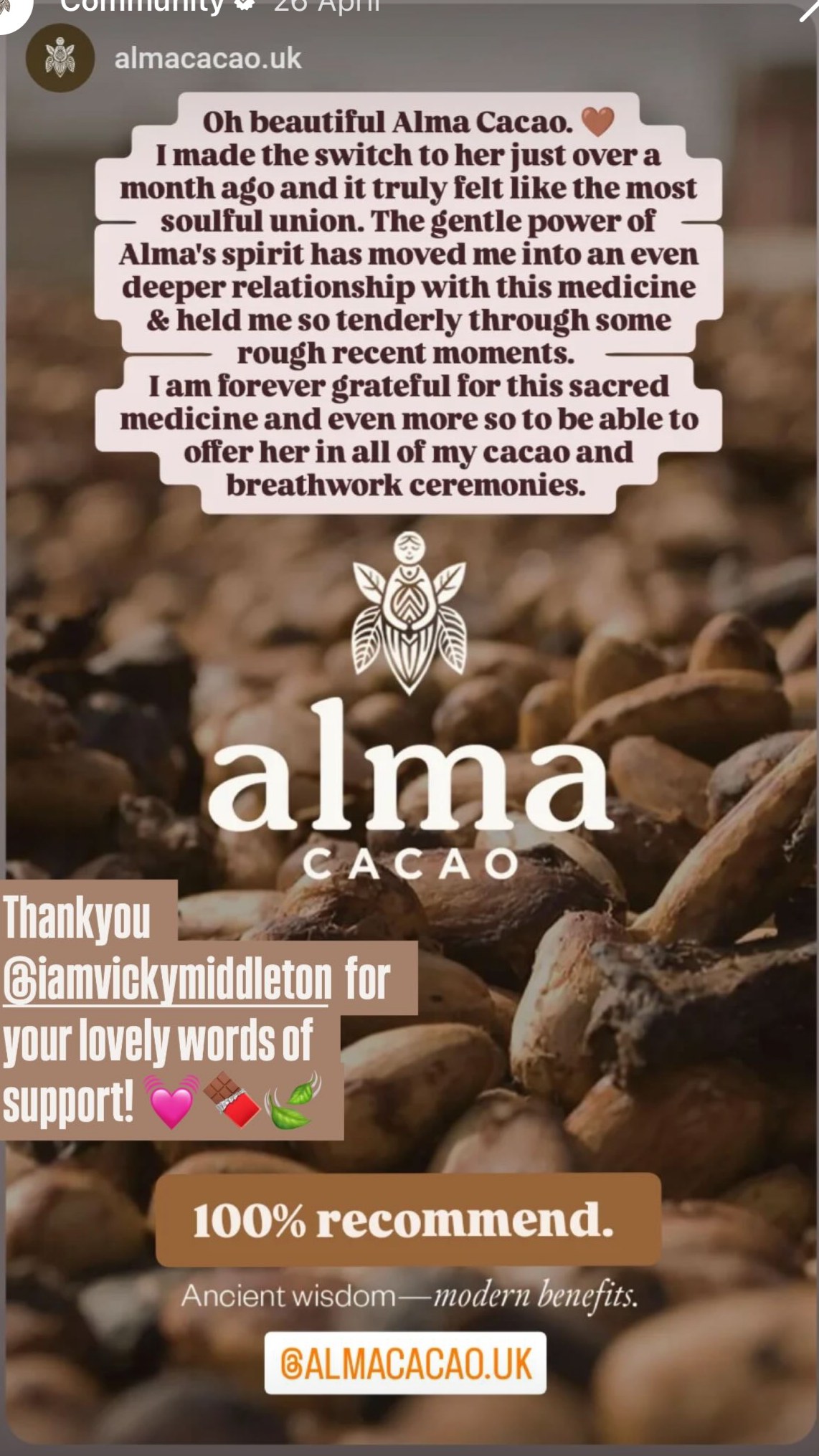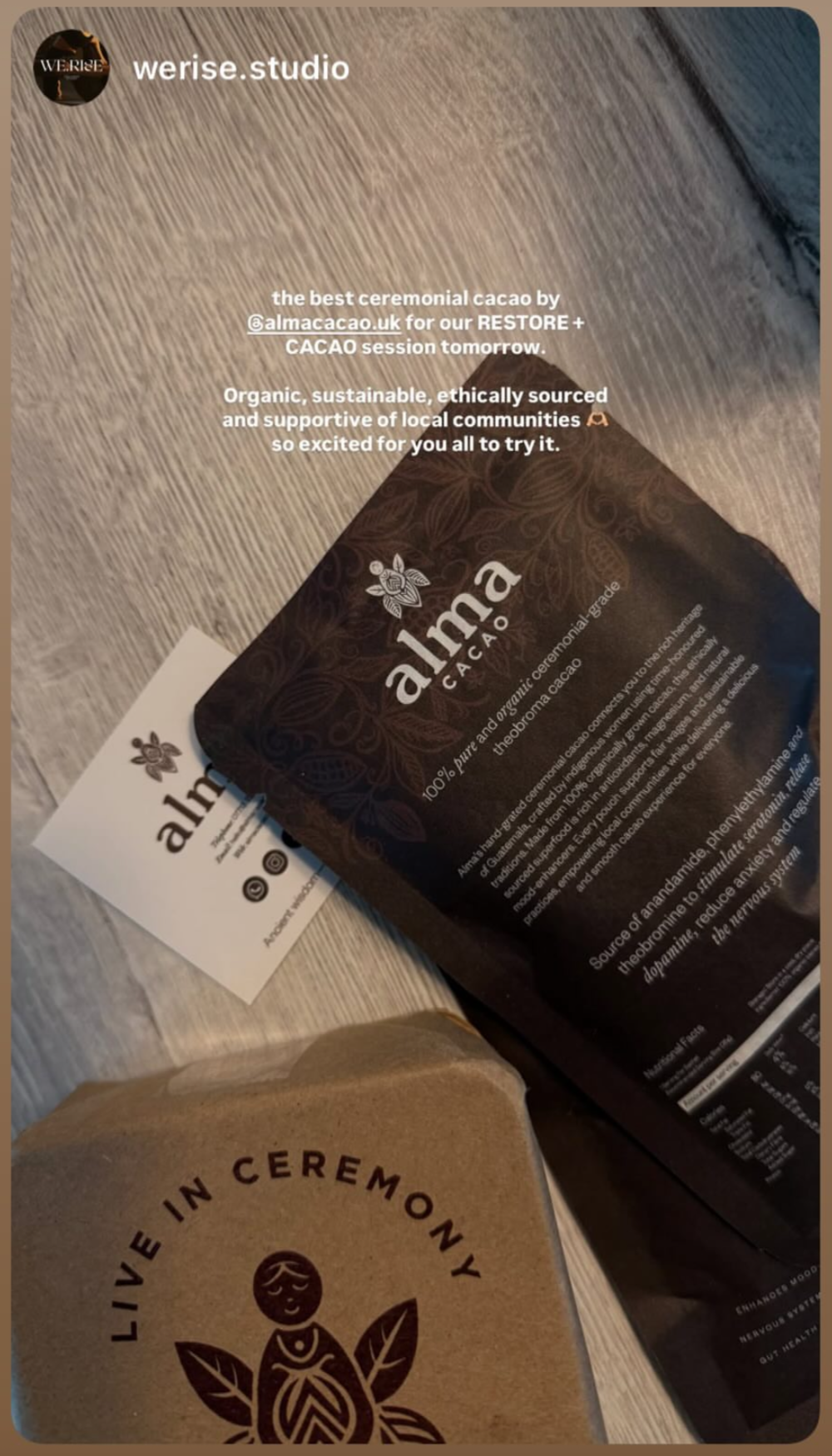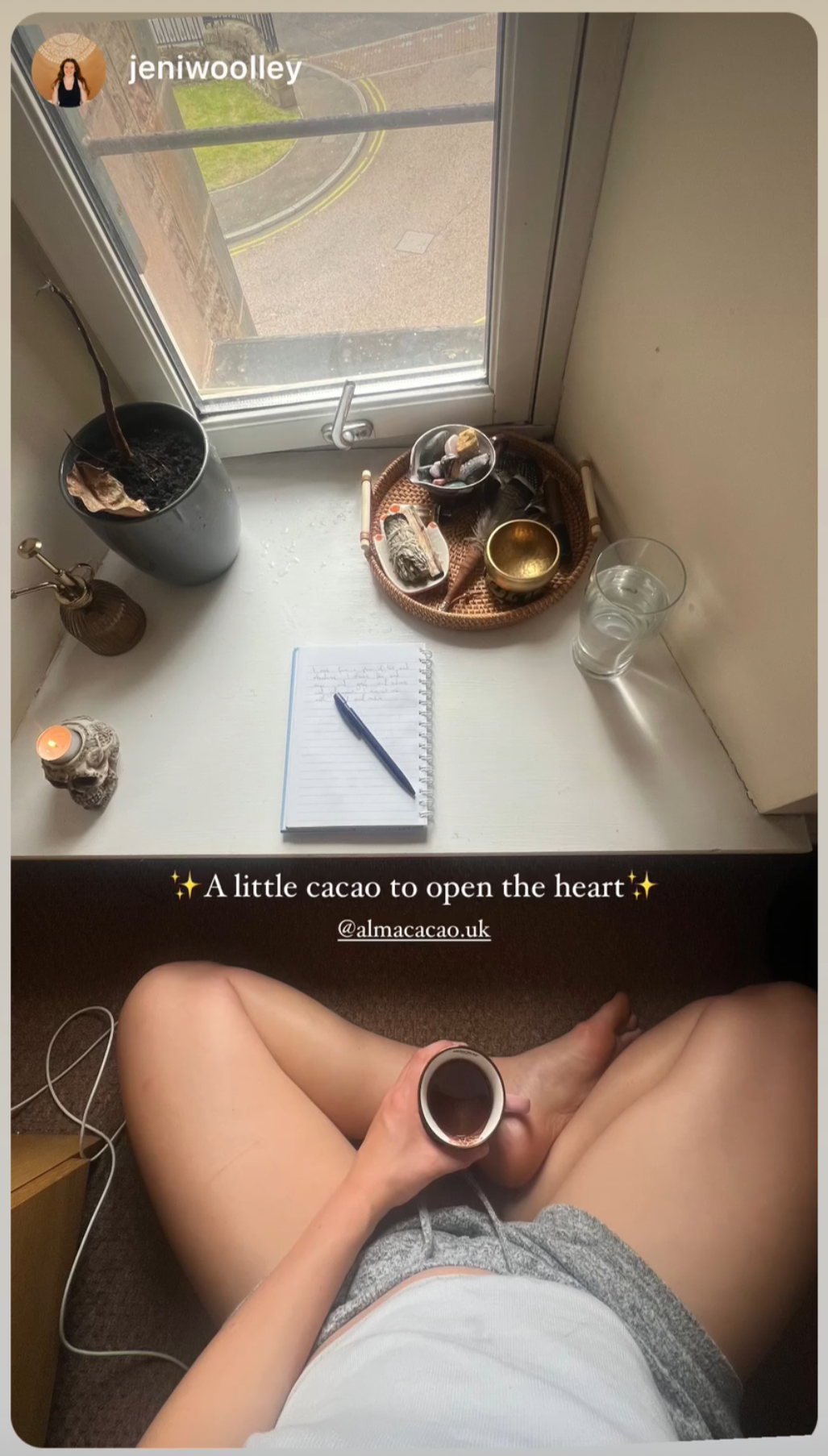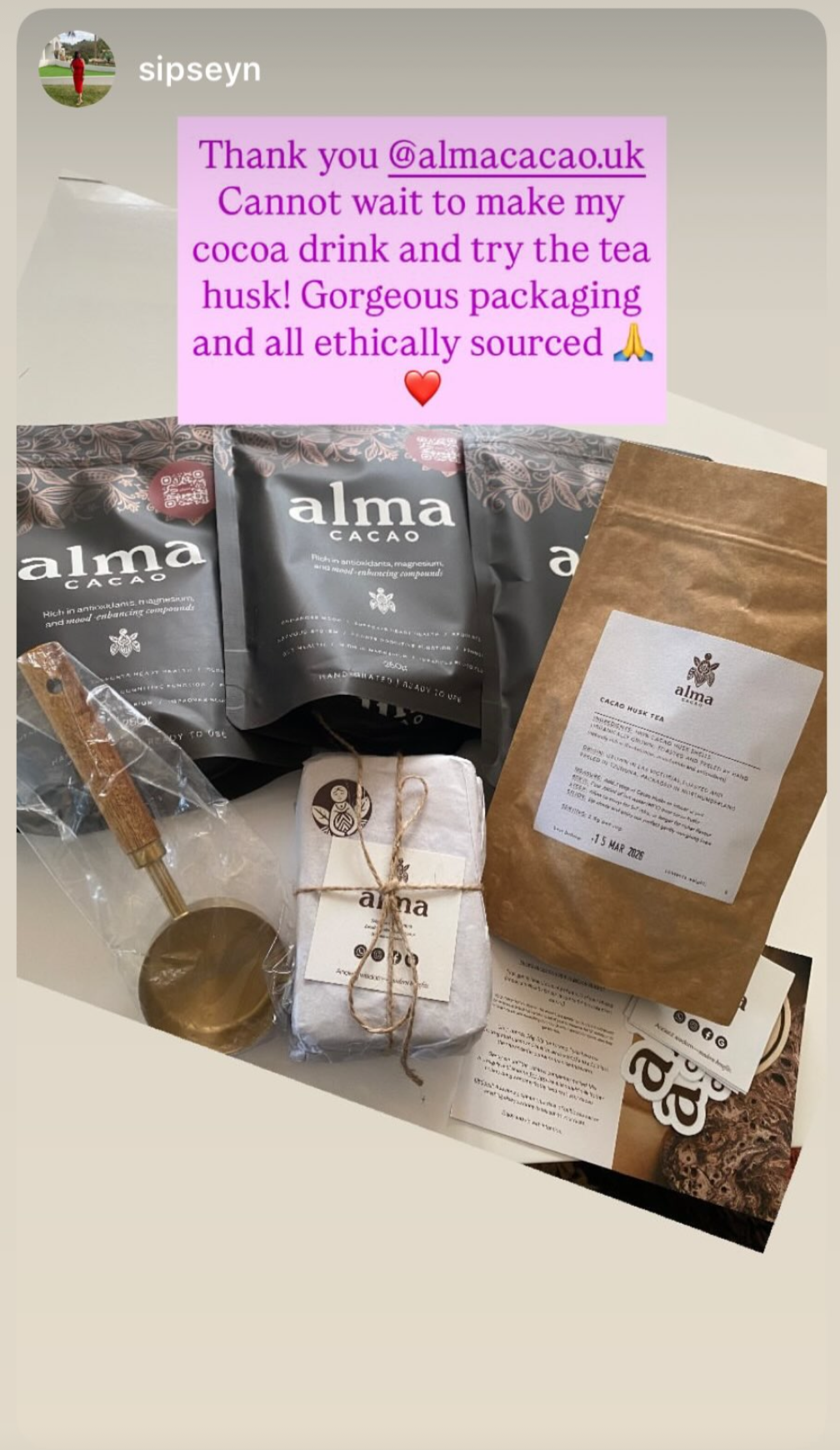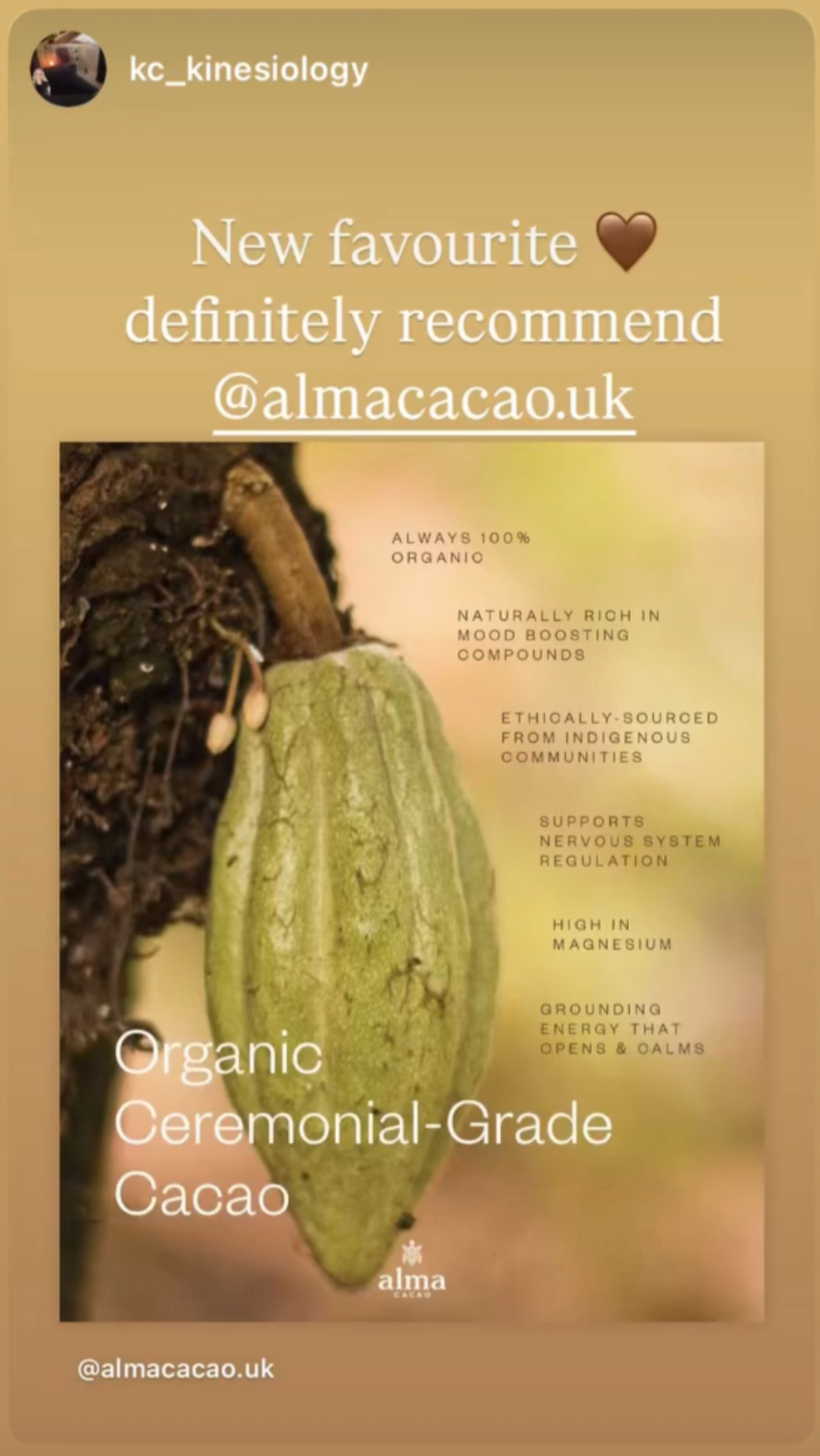Provide additional details about the offer you're running.
What is Ceremonial Cacao?
A beginner's guide to the origins, uses and benefits of ceremonial-grade cacao
So. What is Ceremonial Cacao?
In simple terms, cacao is not just a drink—it’s a potent, mood boosting ritual in a cup. Ceremonial cacao is 100% pure, minimally processed cacao paste, traditionally used in indigenous ceremonies and now embraced for its powerful benefits for our bodies, brain, and heart.
Don’t be fooled—this is not ordinary hot chocolate. Ceremonial cacao is both an ancient tradition and a modern superfood. It’s a rich and deeply nourishing medicine for modern times.
In this guide, we’ll explore the roots of cacao, what makes it ‘ceremonial’, all the different ways you can use it, and why it’s quickly becoming the cornerstone of the wellness world. Strap yourselves in: this is your Cacao 101.
The short answer? Yes—it’s perfectly fine. In fact, that natural pattern, known as fat bloom, is part of cacao’s charm. Here’s why it happens, what it means, and why we actually embrace it (and you should too).
What Makes it 'Ceremonial?
If you’re anything like us, your first question might be: what exactly makes it "ceremonial"?
Well, here’s the truth: there’s no official definition. With no regulatory standards in place in the cacao industry, it comes down to the honesty and integrity of the people making it. That means not every cacao branded as "ceremonial" lives up to the name. Put simply–not all cacao is created equal.
At Alma Cacao, after time spent living and learning in Guatemala, here’s what ceremonial cacao means to us:
- Purity: It must be 100% organically grown and unprocessed. No sugar, no additives, no dairy. The beans should ideally come from a single farm, or at the very least the same region.
- Process: Every step in the process should be done by hand using traditional methods passed down for generations. Proper fermentation, slow drying, gentle toasting — these aren’t just technicalities; they’re essential for preserving the natural compounds that give cacao its magic.
- Intention: This is harder to define but impossible to ignore. The reverence and presence of those growing, preparing, and serving the cacao matter as does the intention you hold when you drink it. We've felt the difference, and we know you will too.
Ceremonial cacao is typically sold as a solid paste (not powder), made from whole ground cacao beans. It retains all its natural fats and minerals, unlike cocoa powder which is heavily processed, heated at high temperatures and stripped of its natural theobromine fatty butter–and stripped of its benefits in the process.
So, when we talk about ceremonial-grade cacao vs cacao vs cocoa, we’re talking about a world of difference — in taste, texture, integrity, and impact.
Not all cacao is created equal. Our cacao is grown in the highlands of Guatemala on a single farm and handmade by a women-led Mayan collective. Every bar is crafted with care, respect, and tradition. Our cacao is unprocessed, untempered—and you can taste (and feel) the difference.
The Origins and History of Cacao
Ceremonial cacao has deep roots in ancient Mesoamerica, where the Mayans and Aztecs honoured cacao not just as food, but as a sacred plant spirit—a divine bridge between the physical and spiritual realms.
Among the Mayan people, cacao was used in ceremony, initiation, and daily ritual alike—offered to deities, shared in sacred rites, and consumed in preparation for vision quests, weddings, and funerals. Its sacredness was woven into the fabric of life. The word ka’kau appears in ancient Mayan texts alongside depictions of gods pouring cacao from great heights to create a frothy, ceremonial drink
For the Aztecs, cacao was equally revered. In fact, cacao beans were so highly valued they were used as currency — traded for goods and services, and often more valuable than gold. A single cacao bean could buy a tamale; a hundred might get you a turkey. Only the elite — priests, warriors, and nobility—typically drank cacao, and it was believed to bestow strength, clarity, and divine insight.
The name Theobroma cacao, meaning "food of the gods," was later coined by the Swedish botanist Carl Linnaeus, but it echoes what these civilisations knew all along: cacao wasn’t just nourishing to the body—it was medicine for the soul
Importantly, these ancient cultures didn’t separate the physical and the spiritual as modern society tends to. Cacao was food, medicine, offering, and communion all at once. It was a plant that opened the heart and sharpened the mind—used to connect with the divine, with the land, and with one another.
Today, modern cacao ceremonies often draw inspiration from these ancestral traditions—combining indigenous wisdom with contemporary practices of mindfulness, somatic healing, and personal transformation. While the settings may have changed, the essence remains the same: to slow down, to connect, and to listen deeply.
The Benefits of Ceremonial-Grade Cacao
What makes Alma Cacao so unique isn’t just its rich flavour or ancient traditions—it’s the powerful combination of a trio of very special compounds which naturally occur in very high quantities only found in cacao. It is the potent combined relationship between Theobromine, Anandamide and Phenylethylamine working together to create a deeply nourishing mind-body experience which lies at the heart of Cacao’s unique effects as a superfood for the mind, body, heart and (spirit!).
Health nourishing perks rounded up:
- Nutrient-rich goodness: loaded with magnesium, iron, flavanols, and antioxidants that help reduce inflammation and support overall wellbeing.
- Gentle, sustained energy: thanks to theobromine, which sharpens focus and boosts circulation without gripping caffeine jitters.
- Mood-enhancers at work: anandamide and PEA help lift mood, open the heart, and support emotional balance.
- Holistic health in every sip: linked with better cognitive function, cardiovascular health, gut support, and even skin vitality—ceremonial cacao offers benefits you can feel (and science is beginning to affirm)
Curious for the full deep dive? You’ll find a full deep dive into the science behind the health benefits of ceremonial cacao over on our health benefits page.
How to Use Ceremonial Cacao
There are so many different ways to enjoy ceremonial-grade cacao and we’re not here to tell you what’s right and whats wrong.
Ceremonial cacao is incredibly versatile.
To enjoy cacao as a drink is the most common way to consuming this superfood. You can take a look at our personal preparation guide here to learn how to prepare the perfect cup of cacao.
For daily use: We recommend 15-25g of cacao paste added to hot coconut milk.
For ceremonial use: Use higher doses (42g+) and prepare with presence. Set an intention, slow down, and connect. This kind of dose is great for journaling, creative practice, meditation and breathwork.
Cacao can also be added to smoothies, raw desserts, or enjoyed as a rich sipping chocolate. In the summer we have loads of fun making creamy coconut iced cacao lattes!
Ceremonial-grade cacao is a potent superfood and can be a powerful medicine—it's not just another wellness trend.
How to Choose Quality Ceremonial Cacao
Not all cacao is created equal. If you want to experience the true depth, flavour, and benefits of ceremonial cacao, there are a few key things to look out for:
- Grown in one place, not blended with beans from different regions. This preserves the unique flavour profile and energetic quality of that land.
- Stone-ground, poured, and set with care, not processed in industrial machinery. The difference isn’t just in taste, it’s in the spirit of the cacao.
- Grown without harmful chemicals and with respect for the farmers, their communities, and the environment.
- Only one ingredient. Just 100% pure cacao paste, as it’s been enjoyed for thousands of years.
Red flags? Beware of industrial cacao powders being sold as "ceremonial," products with added sweeteners or flavourings, or brands that aren’t transparent about where and how their cacao is grown and made.
At Alma, we've tried to keep things simple—and slow. Our cacao is handmade in Guatemala by a women’s collective using traditional techniques passed down through generations. It’s single-origin, 100% organic, and ethically traded at well above the local wage. Some things simply can’t be rushed and are worth paying more for.
What our customers are saying
FAQs
For us, what makes cacao truly ceremonial comes down to three essential qualities—purity, method of production, and intention. These are the soul of every bar we craft.
Purity means our cacao is 100% organic, single-origin, and free from additives or processing shortcuts. It contains nothing but whole cacao beans, hand-prepared in their most natural and potent form.
Method of Production speaks to how our cacao is made—using ancestral techniques passed down through generations. Each batch is fermented, roasted low and slow, and stone-ground by hand by an indigenous women’s collective in Guatemala. This process honours both the land and the spirit of the cacao, preserving its full nutritional, energetic and cultural integrity.
Intention is the invisible thread that ties it all together—both in how the cacao is made and how it’s meant to be consumed. From the care infused by the women who prepare it, to the mindful way it’s used in ritual, creativity or wellness, Alma Cacao is more than a product—it’s a practice. Sound a bit ‘woo-woo’? Trust us! Try it and feel the difference for yourself.
Alma Cacao is ceremonial cacao, made the right way.
Alma Cacao is 100% pure ceremonial-grade cacao, handmade in Guatemala using traditional methods that preserve its full nutritional and energetic integrity.
Supermarket cocoa powders are typically highly processed, chemically treated, and stripped of cacao’s beneficial fats and compounds. Theyre often treated and heated at high temperatures during the production process which breaks down a lot of the magical compounds which make cacao such a special superfood in the first place!
Unlike these products, our cacao retains 100% of its natural oils, minerals, and mood-enhancing compounds—offering a deep, rich flavour and a powerful, nourishing experience. We don’t view cacao as just another ingredient — We understand that cacao is an ancient tradition, a daily ritual, a functional superfood, and the opportunity for us to connect to something deeper in the everyday.
Firstly, cacao is not a sweet drink (unless you add something), and that’s the beauty of it.
Ceremonial cacao has a rich, earthy depth unlike anything you’ll find in mass-produced cocoa or chocolate. Its taste is bold, complex and completely unique —think deep dark chocolate with subtle notes of fruit, spice, and smoke, depending on the region and roast. This is cacao in its purest form, full of character, with a creamy texture that comes from its natural cacao butter—never removed or diluted.
You can prepare Alma Cacao to suit your personal preference for taste. Drinking it with only water will be a lot more of a strong and bitter taste than blending it with 50% oat or coconut milk (our favourite!) which produces a delicious smooth and creamy taste.
Our founder Craig prefers the sharp bitter taste and drinks his morning cacao with only hot water whereas Amy prefers the smooth creamy taste of coconut milk and honey blended for her morning ritual - so there really is no ‘right or wrong way’ – there’s only your way.
At Alma Cacao, we don’t just mass produce cacao and call it ceremonial—we honour it.
Every bar is handcrafted using traditional, time-honoured methods that preserve the full integrity of the bean and the traditions where these methods come from. Unlike industrial production, which often separates and removes the natural oils and compounds, we keep everything intact: theobromine, anandamide, PEAs, and the rich natural cacao butter. These elements aren’t just good for you—they’re what give our cacao its signature velvety texture and deep, layered flavour.
Our cacao is made entirely by hand—harvested, peeled, and stone-ground by an indigenous women’s collective in Guatemala—ensuring every bar carries the care, skill and spirit of the people who make it. It’s cacao with a heartbeat.
Preparing cacao at home is simple and easy and can be varied to suit your own taste and preference. Here’s our go to recipe to get you started:
- Gently heat a cup’s worth of ½ water / ½ plant milk of your choice (coconut is our favourite!). *Don’t boil, this should be a gentle heat and the liquid should never boil–We’ve taken a lot of care to preserve the full spectrum of natural fats, oils and nourishing compounds which can be broken down if they get too hot.
- Chop approx. 25g (or 1 scoop if you have our hand-grated cacao and custom alma scoop) and add this to the pan once the contents are nice and warm.
- Gently stir until the cacao is melted. Top tip: use a handheld milk frother here to give bring a creamy frothy texture to your cacao.
- Optional: Add honey, cinnamon, a dash of celtic sea salt or anything else you fancy to season to your taste.
- Enjoy and sip with intention.
Alma Cacao is designed for both. While it’s potent enough for ceremonial depth, it’s also gentle and nourishing for daily life. Whether you're journalling, working, creating, or simply grounding into your morning, our cacao meets you where you are—ritual optional, benefits always included.
In fact one of the core reasons why we created Alma was to help gently bring ceremonial-grade cacao out of the exclusive ceremony space where many people don’t feel comfortable. Its our intention that ceremonial-grade cacao has an important role to place in the everyday lives of everyday people.
There is no denying that Ceremonial-Grade Cacao holds the undisputed title of the Original Superfood with benefits for both body and mind. It’s packed with antioxidants, flavonoids and essential minerals (like magnesium and iron) that support heart and brain health and overall wellness.
It's the powerful combination of a trio of very special compounds which naturally occur in very high quantities only found in cacao. It is the potent combined relationship between Theobromine, Anandamide and Phenylethylamine working together to create a deeply nourishing mind-body experience which lies at the heart of Cacao’s unique effects as a superfood for the mind, body, heart and (spirit!).
Unlike coffee, cacao provides a gentle energy boost through theobromine, a mild stimulant that enhances focus and mood without the jitters or crash of caffeine. It also contains mood-elevating compounds such as anandamide and PEA (phenylethylamine). These are often called the “bliss” and “love” chemicals, known for promoting positive feelings, clarity, and stress relief. Many people find that enjoying pure cacao helps them feel more centered, uplifted, and connected.
We’re serious about the science-backed health benefits of ceremonial cacao and if you’re a cacao-science nerd like us then you can check our health benefits page for a deeper dive into the health science of this soulful superfood.
Alma Cacao contains no added caffeine, but it does contain a naturally occurring compound called theobromine – a gentle stimulant found in cacao that offers a sustained energy boost without the spikes and crashes of coffee.
Theobromine primarily stimulates the cardiovascular system (rather than the central nervous system like caffeine), making it less likely to cause jitteriness, anxiety or sleep disturbances. Many people find that cacao actually calms the nervous system while increasing focus and alertness. That said, everyone is different – if you're especially sensitive to stimulants, we recommend enjoying your cacao earlier in the day to see what works best for your body.
Every experience is unique – but most people describe ceremonial cacao as heart-opening, grounding, and gently uplifting. Thanks to its natural compounds like anandamide, PEA, and theobromine, cacao can create a sense of calm focus, lightness in the heart, and deeper emotional connection.
Cacao is non-psychoactive and is not a hallucinogen. It can create feelings of bliss and joy and openness depending on the dosage used.
You might feel more present, more creative, or simply more you. That’s why so many people use it to support meditation, journaling, deep work, or even just a mindful ritual to start their day. The best way to understand how cacao feels? Try it and see what it brings up for you.
Here you can place an explanation or answer to the question.
Not at all. Cacao can be used however it best serves you. For some, it’s a tool for emotional healing and spiritual connection. For others, it’s a nourishing daily ritual that supports energy, focus, and mood.
You don’t need to subscribe to any particular belief system to enjoy cacao. What matters most is that you approach it with presence, care, and respect—for the plant, for yourself, and for the people who grew and made it.






